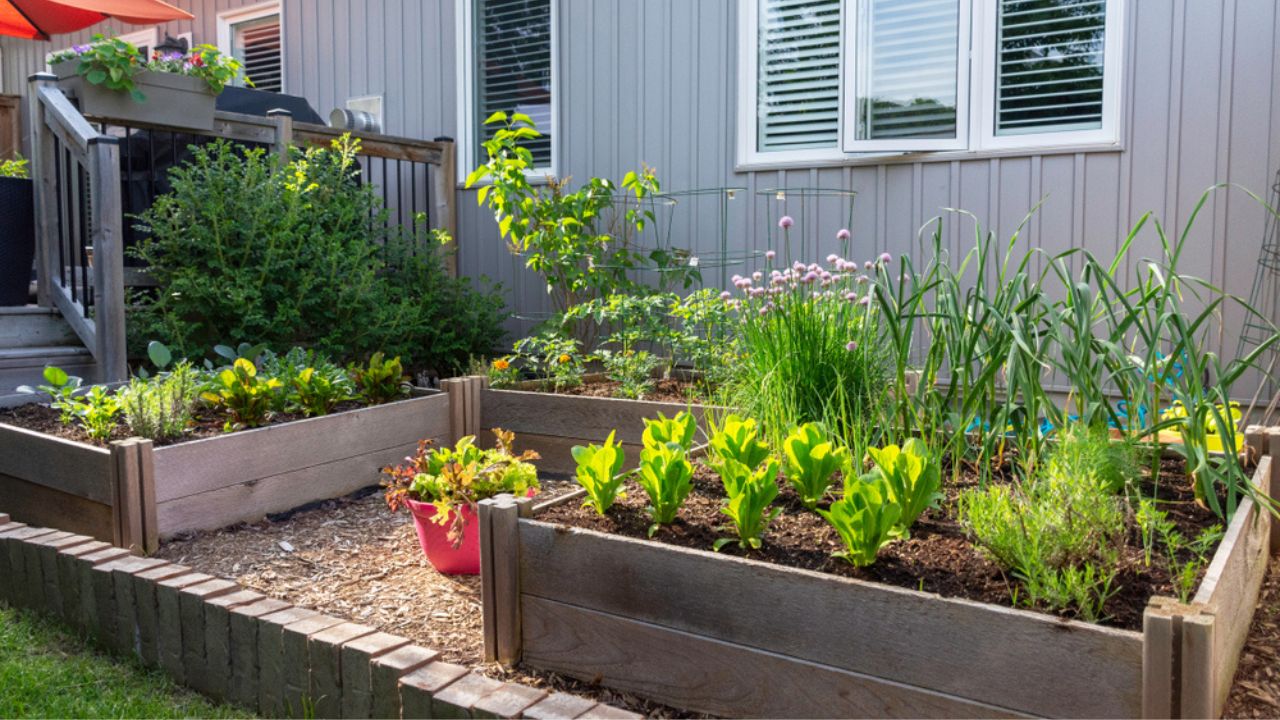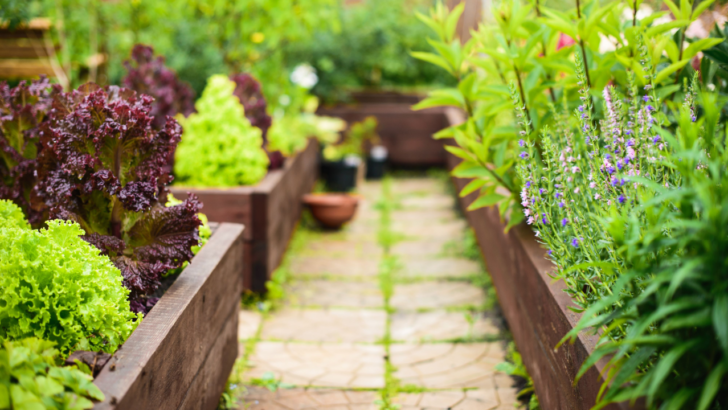What if, instead of being the source of a groan-inducing, time-consuming chore (mowing), your lawn became a food source?
Imagine ditching the mower for fresh fruits, veggies, nuts, and even eggs. There are many reasons to grow food, not lawns, and the transition from grass to greens can be relatively simple. No matter how big or small your yard is, you can make it both productive and beautiful.
Why You Should Grow Food, Not Lawns
According to the National Wildlife Center, as much as 40 million acres of land in the U.S. consists of manicured lawns. And all that space provides little to no habitat for important pollinators and other wildlife.
In fact, it does quite a bit of harm through the use of chemical fertilizers and pesticides each year. Additionally, irrigation for lawns uses nearly 9 trillion gallons of water, and lawnmowers consume millions of gallons of gas annually. That’s a lot of resources for largely unused space.
Of course, you might have a lawn for your kids, pets, or even yourself to play on, and that’s great! But do you really use all of it? Perhaps there’s a large section toward the back that rarely sees foot traffic except for occasional stray ball retrieval, or maybe the front lawn simply exists for its ornamental value. If you want to keep some lawn, mark off only as much as you need, then turn the rest into a beautiful, edible garden.
Benefits of Growing Food Instead of a Lawn

Image Credit: Shutterstock.
In case you’re still not convinced, here are some excellent reasons to tear up that grass:
- Spend less time (and gas) mowing
- Create a beautiful landscape from a blank space
- Provide habitat for birds, butterflies, and other wildlife
- Grow fresh, healthy food for your household
How Do I Turn My Lawn Into a Garden?
Now that you know the why, how do you switch from a resource-hungry lawn to a food-producing garden?
First, decide how much lawn you want to tackle at one time. If you have a small yard or are only converting a small part of it, you might be able to do it all in one go. But if you have a lot of lawn to transform, building your garden one section at a time over two or three years will be more manageable.
Once you’ve marked off the area to convert, you have to get rid of all that grass. You can do this by digging it all up, smothering it, or combining the two.
Dig or Cover, and Reset for Spring
Weedy lawn or invasive, creeping grass like crabgrass should be dug up to reduce the chances of weeds popping up all over your new garden. Use a shovel or sod cutter to remove the lawn, or hire someone to do it for you.
Chickens are also surprisingly effective at destroying small sections of grass, so if you want to raise your own eggs, too, now is a great time to get a few hens (if you live in town, check local laws first).
Try sheet mulching for an effective, organic, low-cost way to smother the lawn. Cover the entire space in a thick, overlapping layer of cardboard or newspaper, spread a few inches of straw or chopped leaves on top, and finally, add compost and topsoil.
Hose down each of the first two layers to encourage decomposition. Before laying down the straw or leaves, mark out where any paths will be and cover those areas with your desired path material instead of the mulch and soil.
You can also build raised garden beds on top of the cardboard and fill the space around them with gravel, bark mulch, and stepping stones. For in-ground beds, stones or pavers help create attractive, clean lines between the garden beds and paths.
It’s best to complete this process in the fall so everything has time to break down before you plant in it, but you can certainly put plants in right away if you prefer.
What Do I Plant in My New Edible Landscape?
Although you can plant whatever you want in your new garden, the Food Not Lawns movement encourages the use of permaculture, a set of holistic, sustainable design principles inspired by nature.
For especially low-maintenance food production, start by planting fruit trees, berry bushes, and perennial vegetables and herbs, choosing native varieties whenever possible. Plant a few native flowering perennials for bursts of color and to attract pollinators and other beneficial insects.
Put taller plants in the back with progressively shorter plants in front, staggering them for a more natural appearance. Consider planting a fruit tree in the center of the garden as a focal point, with shade-tolerant perennials underneath and others radiating outward. Designate a few beds for annual vegetables and herbs, or simply scatter them among the perennials.
It will likely be simplest to keep the annuals closer together for irrigation purposes.
Can You Plant Vegetables in Your Front Yard?
Maybe you’re convinced that replacing your lawn with an organic garden is a great idea, but you’re concerned about curb appeal if you plant vegetables in your front yard. After all, tomatoes can get rather unruly!
One popular way to do this is by installing raised beds to create an attractive, orderly appearance with clean lines. A similar effect can be achieved for in-ground beds with borders of stone, pavers, or brick.
For the plants, consider attractive perennials like plum trees or blueberry bushes. Herbs also come in a beautiful array of textures and colors. For example, creeping thyme makes a nice edible ground cover.
To dress up annual veggies, use the layering approach mentioned above: taller plants in the back and shorter ones in the front. You can also get creative with the design, such as planting lettuce or other greens along the edge of a bed as a border.
Of course, don’t forget edible flowers like nasturtiums, sunflowers, and pansies, or companion plants like marigolds. For those ungainly tomatoes, look for determinate varieties, which only grow to a certain height, making them easier to control.
You can also train pole beans and other climbing plants up decorative (yet sturdy) trellises.
Books About Growing Food Instead of Lawns
For a deeper look into turning your lawn into fresh food, check out a book or two on the subject, such as those suggested below.
Book # 1: Food Not Lawns: How to Turn Your Yard into a Garden and Your Neighborhood into a Community, by H.C. Flores
Written by a co-founder of the Food Not Lawns organization, this book is an excellent place to start. As you would expect with a “how-to” subtitle, it provides a nine-step permaculture design to help readers build their own edible landscape.
It also goes a step further, serving as a full lifestyle manual inspiring the application of simplicity, resourcefulness, creativity, mindfulness, and community in the garden and all aspects of life.
Book # 2: The Edible Front Yard: The Mow-Less, Grow-More Plan for a Beautiful, Bountiful, Garden, by Ivette Soler
This book answers the question of how to incorporate vegetables into a beautiful front yard. Step-by-step instructions help readers transform part or all of their lawn into a vegetable garden without losing curb appeal.
With helpful design advice, learn which edible plants are most attractive and how to place them in decorative ways.
Book # 3: Edible Landscaping: Now You Can Have Your Gorgeous Garden and Eat It Too! by Rosalind Creasy
More than three hundred full-color photos provide inspiration alongside the informative pages of this book, which describe how to grow vegetables, fruits, berries, and nuts in a beautifully designed home landscape.
In addition, an “Encyclopedia of Edibles” provides information on individual plants, and the appendices include organic methods for controlling pests and diseases.
Get Growing!
If you have an unused portion of lawn surrounding your house, it’s time to put the mower away and nourish the soil and yourself. Whether you take a wilder approach or design an orderly landscape, you can transform your outdoor space into a beautiful, bountiful garden.



Drought Tolerant Landscaping Ideas For Your Yard
Friday 30th of October 2020
[…] Without a lawn, there is little else that needs doing on a weekly basis. Learn more about planting food instead of lawns. […]
How To Grow A Victory Garden - Step By Step Guide With Pictures
Friday 30th of October 2020
[…] Related: grow food not lawns! […]
Creative Water Conservation Landscaping Ideas For A Greener Yard
Friday 23rd of October 2020
[…] You might want to turn some of your outdoor space into an edible landscape. […]